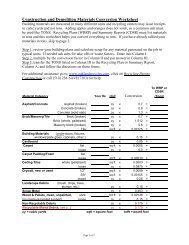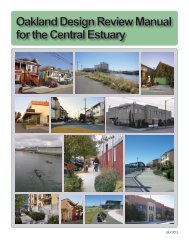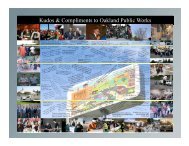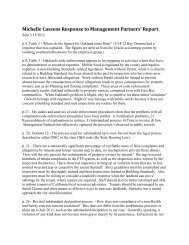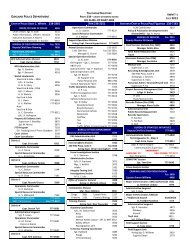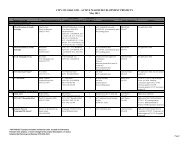Intelligent Transportation Systems - City of Oakland
Intelligent Transportation Systems - City of Oakland
Intelligent Transportation Systems - City of Oakland
You also want an ePaper? Increase the reach of your titles
YUMPU automatically turns print PDFs into web optimized ePapers that Google loves.
projector technology and the flat screen display technology. Projector technology<br />
involves the use <strong>of</strong> a projector (front or rear) to reflect an image from a mirror onto a<br />
large screen. The most common rear screen projectors are the Liquid Crystal Display<br />
(LCD) type and the Digital Light Processing (DLP) type. Typically, flat screen system<br />
utilizes gas plasma screens to display images. However, gas plasma screens are more<br />
susceptible to “screen burn” from common images being displayed on a continuous<br />
basis.<br />
When CCTV surveillance cameras are installed in the future, the camera images can be<br />
configured to be displayed on the large screen display to provide a focal point for the<br />
TMC.<br />
Operator Consoles – The operator console is where the TMC management staff will<br />
perform the majority <strong>of</strong> their duties and should provide enough work space to<br />
accommodate for both on-line and <strong>of</strong>f-line activities and responsibilities. Therefore, when<br />
an operator is not working with the traffic control system (typically non-peak hours)<br />
he/she may perform other assigned day-to-day activities such as traffic analyses and<br />
report writing. There will be one operator working at each console.<br />
The consoles should be designed to support the video display systems and computer<br />
monitors as well as to provide desk space and an area for a keyboard. The consoles<br />
should be placed side-by-side, each in an “L” shaped configuration to facilitate<br />
interaction between the operators. The console hosting the computer can have<br />
keyboard trays and should have cable guides. A minimum <strong>of</strong> 3 feet by 3 feet <strong>of</strong><br />
horizontal table space for each computer monitor is recommended. The 3-foot minimum<br />
depth will provide the operator with adequate tabletop space for other materials, and<br />
allows for the monitors to be placed the appropriate distance away from the operator. It<br />
is desirable to provide room for under-console CPU storage on a retractable shelf for<br />
easy access. The keyboard trays should raise and lower so wheelchairs can get under<br />
the trays.<br />
A 27” vertical knee clearance should be provided at the console. The use <strong>of</strong> a<br />
"submerged monitor" computer desk should be avoided since it limits legroom, has a<br />
significantly higher cost, and places the monitor at too low a position for long-term<br />
continuous use by an operator.<br />
The console furniture should be modular to allow the accommodation <strong>of</strong> future<br />
technology upgrades and be ergonomically adjustable to fit individual operator size and<br />
preferences.<br />
Other Furniture – A small table or desk will be provided on one side <strong>of</strong> the room to<br />
house a controller testing area. The testing area will allow a signal controller to be<br />
connected to one <strong>of</strong> the workstations for testing and training purposes. A supplementary<br />
desk can be provided at the operator console area to supply additional workspace for<br />
the operator. Book shelves and file cabinets can be used to provide storage for manuals<br />
and reference materials. Additional chairs should be provided for visitors and the<br />
supervisor. Since the <strong>City</strong> <strong>of</strong> <strong>Oakland</strong> intends to use the TMC room as a conference<br />
room on occasion, a conference table and chairs should be provided in the back <strong>of</strong> the<br />
control room as well.<br />
<strong>City</strong> <strong>of</strong> <strong>Oakland</strong> ITS Strategic Plan<br />
90 September, 2003







